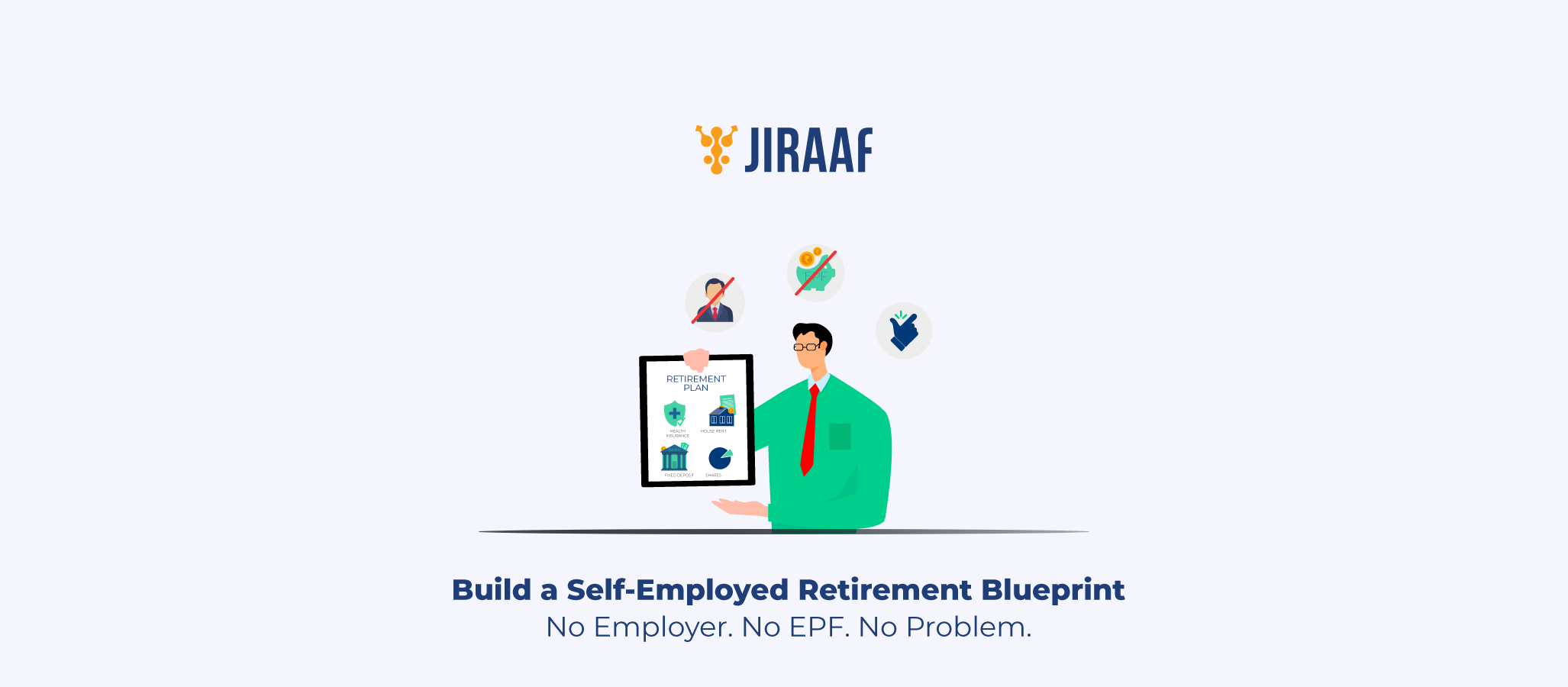When you run your own show professionally, no one hands you a retirement plan with your appointment letter. There’s no EPF pension plan, no employer contribution, and definitely no built-in exit strategy. You’re the one designing every piece of the puzzle, including how your post-work life gets funded.
Despite that reality, most self-employed professionals in India put off serious retirement planning. It’s mainly because retirement plan options for self-employed individuals feel like decoding a system that is not built for their needs as well as it is for salaried employees.
You might need some help to navigate this unfair system confidently and derive a strong retirement plan that serves you well. In this blog, we have included in this blog some effective tools, strategies, and trends to help you navigate the self-employed retirement labyrinth better. Let’s have a look.
What is a pension plan?
A pension plan helps you turn your savings into a structured income after you retire. You accumulate wealth during your active years and then draw it down systematically, either as regular income or lump sums, once you stop earning.
In India, pension products usually follow two phases: accumulation and distribution. You build a retirement corpus through regular contributions and invest it across different assets. Later, this corpus funds your retirement, typically through an annuity or phased withdrawals.
For the self-employed, understanding how pension plans work in India means going beyond basic features. You must assess investment flexibility, risk management, tax treatment, and liquidity. After all, the best pension plan for self-employed individuals needs to function as both a growth engine and a personal safety net.
Pension Plan Options for Non-Salaried Individuals
National Pension System (NPS) for Self-Employed
NPS remains one of the best retirement plan options for self-employed professionals in India. You get equity-debt exposure, low costs, and expert fund management, all in one product. Your contributions to NPS also qualify for tax deductions under Sections 80CCD(1) and 80CCD(1B), making it highly tax-efficient.
Atal Pension Yojana (APY) for Freelancers
APY caters to lower-income freelancers and gig workers. With guaranteed pensions from ₹1,000 to ₹5,000 per month post-60, it works best as a supplementary plan rather than your primary retirement solution. Its affordability and government backing make it a reliable base layer in your portfolio.
Public Provident Fund (PPF)
Risk-averse investors often rely on PPF as a secure, long-term savings instrument. Its tax-free interest and sovereign guarantee make it an ideal debt component in a retirement portfolio. With a 15-year lock-in and optional extensions, PPF remains a low-risk pillar in a self-employed individual pension plan.
Unit-Linked Pension Plans (ULPPs)
ULPPs combine life insurance with market-linked investment. While they offer capital appreciation potential, they also have charges and are inflexible compared to mutual funds. You should, however, evaluate ULPPs carefully against direct equity investments or hybrid mutual funds before opting in.
Annuity Plans
If you prioritize post-retirement stability, annuity plans offer fixed or inflation-linked payouts. They’re best suited for professionals in their 50s or early 60s looking to convert part of their corpus into assured monthly income. Annuities aren’t ideal for high-growth needs, but can anchor the safety side of your portfolio.
Guaranteed Return Pension Plans
Products like LIC New Jeevan Shanti, Bajaj Allianz Life LongLife Goal (Guaranteed Variant), and others offer predictable returns, often with capital protection. They suit risk-averse individuals nearing retirement who prefer certainty over market-linked returns. Some plans even lock in rates upfront, removing reinvestment risk in volatile interest environments.
Self-directed Pension Plans (SIPPs)
While India doesn’t have SIPPs as a product, for those confident in managing their portfolios, SIPPs are a flexible way to build a retirement corpus. You allocate your money across mutual funds, ETFs, REITs, and debt instruments based on your own strategy. They offer you full control, but you must stay disciplined and tax-efficient.
Tax Benefits of Retirement Plans for Self-Employed Professionals
Tax optimization is a critical layer in any retirement strategy. Here’s how the right retirement plans help reduce your tax burden:
- NPS Pension Plan: This offers you up to ₹2 lakh in deductions annually: ₹1.5 lakh under 80C and an additional ₹50,000 under 80CCD(1B)
- PPF and ULPPs: These provide you tax-free returns under the EEE (Exempt-Exempt-Exempt) regime
- Annuity Plans: Their payouts are taxable as income, but if planned right, these can fall in a lower slab post-retirement
- SIPPs and Mutual Funds: These enable long-term capital gains planning, especially under ₹1 lakh annually, which remains tax-free
Building a Retirement Corpus Without Employer-backed Schemes
You don’t need an employer to build a pension plan. You need systems.
- Start with automation. Set up SIPs in NPS, mutual funds, and PPF to create a disciplined cash flow into your retirement portfolio. Treat your contributions like mandatory expenses.
- Separate your emergency fund and insurance. This frees up mental bandwidth to focus solely on growth-oriented retirement instruments. Avoid mixing goals; retirement planning deserves its own track.
- And finally, review your corpus targets annually based on lifestyle, inflation expectations, and market performance. Adjust your strategy as your business grows or your income becomes more stable.
Importance of Early Contributions
Let’s be clear: more than needing to time the market, you need time in the market. Starting early allows your money to work harder with less effort from you.
For example, if you invest ₹10,000 monthly from age 30 to 60 at 10% CAGR, you will have ₹2.28 crore. But if you start at 40, even with double the amount (₹20,000), your corpus at 60 will ONLY be ₹1.44 crore. So, it’s about starting early rather than investing a higher amount at a later stage in life.
Plus, early investing gives you room to take risks and time to recover from market dips. You can also allocate more to equity in your early years, boosting long-term corpus potential. Waiting until your income stabilizes often delays the most powerful years of compounding.
Long-term Strategies to Build Your Corpus
To build a resilient corpus, treat your retirement planning like running a business.
- Diversify across instruments: Investing in options like NPS, mutual funds, PPF, and even an individual pension plan with guaranteed returns can balance your growth and security.
- Rebalance annually: Market cycles change asset weights, so try to adjust them based on your age and risk tolerance.
- Use SWPs for tax-efficient income: Use SWPs from mutual funds to generate retirement income more tax-efficiently. Capital gains are taxed only on the withdrawn amount, unlike annuities, which are fully taxable.
- Protect liquidity: Keep some of your assets easily accessible to avoid forced withdrawals during down markets.
- Plan to exit in time: Structure phased withdrawals with minimal tax leakage well before you turn 60.
Additional Insights on Retirement Planning
Leveraging Technology for Better Planning
Investment platforms now provide unified dashboards, real-time tracking, and AI-based portfolio recommendations, tailored to fit different retirement goals. Many options also offer automation tools that help you stay consistent, a major advantage when you don’t have an employer handling deductions. Use tech not just to track but also to stay accountable.
Financial Wellness Frameworks
Even without an HR department, you can create your own system:
(i) Set quarterly goals
(ii) Maintain separate retirement and business accounts
(iii) Conduct annual reviews
(iv) Build a buffer alongside your long-term plan
These habits help maintain momentum and make course corrections as needed.
Inflation-proofing of Your Strategy
A monthly expense of ₹50,000 today could become ₹100,000 in 20 years at 4% inflation.
Counteract this through:
- Higher equity exposure in your early years
- Real estate or REITs as inflation hedges
- Inflation-linked annuities or index funds
Don’t just plan for today’s prices; build for tomorrow’s reality.
Expand Your Tax Efficiency
Explore options beyond deductions:
- Use income-splitting with your spouse (if applicable) to lower tax brackets post-retirement.
- Harvest capital gains strategically to remain within zero-tax thresholds.
- Layer your products by tax status. For flexibility, combine PPF (EEE), NPS (deferred), and mutual funds (variable tax).
Conclusion: Tailor Your Retirement Plan to Your Self-Employed Needs
You’ve built your unique business at the cost of a corporate safety net. There’s no reason your retirement plan should be off-the-shelf.
By leveraging modern pension solutions, optimising tax strategies, and staying committed to long-term contributions, you can achieve the freedom to walk away on your own terms, with your lifestyle intact.
Discover fixed income investments with Jiraaf, a SEBI registered online bonds platform that educates and brings access to a wide array of bonds. Sign up today to explore diversified fixed income investment opportunities to support your goal-based wealth creation journey. Start investing!



